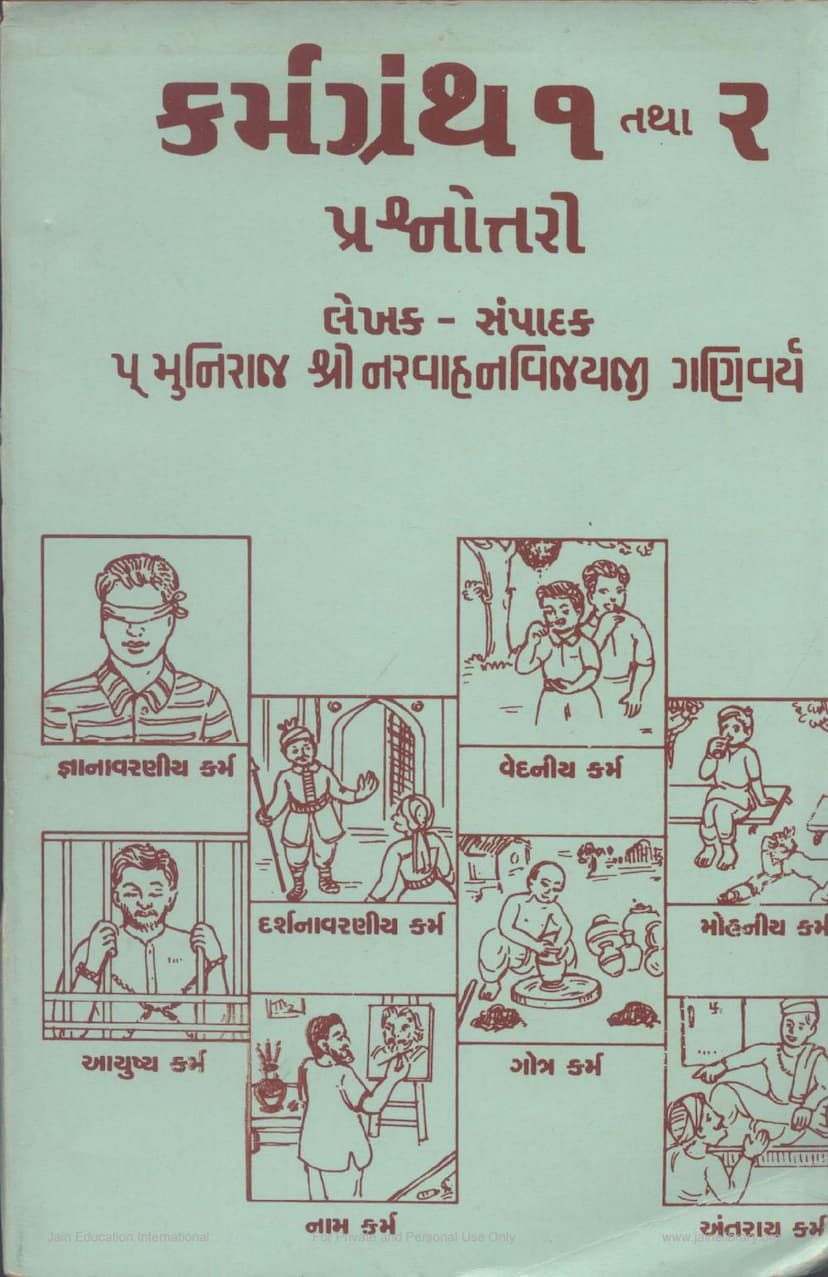Karmgranth 01 And 02 Prashnottari
Added to library: September 2, 2025

Summary
The provided text is a Jain scripture titled "Karmgranth 01 and 02 Prashnottari" (Karmagranth 1 and 2 Questions and Answers), authored by Ganivarya Shri Narvahan Vijayji. Published by Padarth Darshan Trust, Ahmedabad, it is the second edition, compiled by combining the first and second parts of the "Karmagranth Prashnottari" series.
This book is a comprehensive question-and-answer guide to the complex topic of Karmas (actions and their consequences) within Jain philosophy. It systematically explains the fundamental principles of karma, aiming to provide clarity to earnest students and seekers of Jain knowledge.
Here's a breakdown of the key themes and content covered in the text:
Core Concepts of Jain Karma Theory:
- Definition of Karma: The text begins by defining karma as what is done by a soul through various means (hetus). It elaborates on karma as subtle material particles (karmavarghana) that become one with the soul due to specific intentions and actions.
- The Eight Karmas (Mool Prakriti): The book details the eight primary types of karmas:
- Jnānāvaraṇīya Karma (Knowledge-Obscuring Karma): Obscures the soul's inherent knowledge.
- Darshanāvaraṇīya Karma (Perception-Obscuring Karma): Obscures the soul's inherent perception.
- Vedanīya Karma (Feeling-Producing Karma): Causes experiences of pleasure and pain.
- Mohanīya Karma (Delusion-Producing Karma): Causes delusion, attachment, and aversion, leading to confusion and wrong beliefs/actions.
- Āyuṣya Karma (Life-Span Karma): Determines the duration of life in a particular birth.
- Nāma Karma (Name Karma): Responsible for the physical form, characteristics, and various attributes of a being.
- Gotra Karma (Status Karma): Determines one's social standing and lineage (high or low status).
- Antarāya Karma (Obstruction Karma): Obstructs the soul's inherent abilities like charity, gain, enjoyment, etc.
- Sub-Categories of Karmas (Uttar Prakriti): The text explains that each of the eight main karmas has numerous sub-categories, totaling 158 in all. It lists the number of sub-categories for each of the eight main karmas (e.g., 5 for Jñānāvaraṇīya, 9 for Darshanāvaraṇīya, 28 for Mohanīya, 103 for Nāma, etc.).
- The Four Types of Karma Bondage (Bandh): The book explains the four ways karma binds to the soul:
- Prakriti Bandh (Type of Karma Bondage): The specific nature or quality of the karma.
- Sthiti Bandh (Duration of Karma Bondage): The time period for which the karma will remain with the soul.
- Ras Bandh (Intensity of Karma Bondage): The strength or potency of the karma's effect.
- Pradesh Bandh (Quantity of Karma Bondage): The number of karma particles that bind to the soul.
- Nature of Karma: It is established that karmas are physical (rūpī) in nature, possessing qualities like color, smell, taste, and touch, despite the soul being non-physical (arūpī). The analogy of intoxicating liquor affecting the mind is used to explain this interaction.
- Eternity of Karma: Karma is considered beginningless (anādi) in the stream of existence, though individual karmic bonds have a beginning. The text uses the analogy of gold found in mines, which, though associated with earth from its origin, can be purified. Similarly, beginningless karmas can be shed through spiritual practice.
Detailed Explanation of Specific Karmas and Knowledge Types:
The book then delves into detailed explanations and FAQs about various aspects:
- The Five Types of Knowledge (Jñāna):
- Mati Jñāna (Sensory Knowledge): Knowledge gained through the senses and mind.
- Shrut Jñāna (Scriptural Knowledge): Knowledge acquired from scriptures and teachings.
- Avadhi Jñāna (Pure Perception): Clairvoyant knowledge of subtle and remote objects.
- Manahparyaya Jñāna (Telepathic Knowledge): Knowledge of others' thoughts.
- Keval Jñāna (Omniscience): Complete and perfect knowledge of all things. It further breaks down Mati Jñāna into its 28 types and Shrut Jñāna into 14 or 20 types, explaining the characteristics and nuances of each.
- Obscuring Karmas: Detailed explanations of Jnānāvaraṇīya and Darshanāvaraṇīya karmas are provided, including the reasons for their order and their metaphorical comparison to blindfolds.
- Vedanīya Karma: Explains how it causes pleasure and pain, comparing it to honey mixed with sword-edge.
- Mohanīya Karma: Described as being like intoxicating liquor, it further categorizes it into Darshan Mohanīya (affecting right faith) and Charitra Mohanīya (affecting right conduct), with various sub-types for each.
- Ayushya Karma: Explained as the force that binds the soul to a particular lifespan and existence, comparing it to a chain. It details the four types: Deva, Manushya, Tiryancha, and Naraka Ayushya.
- Nama Karma: Elaborated as the 'artist' karma, creating the form and attributes of beings. It extensively details the 93, 103, and 67 types of Nāma Karma, including the 14 Pind Prakritis, 8 Pratyek Prakritis, 10 Trasa Prakritis, and 10 Sthāvara Prakritis.
- Gotra Karma: Explained as determining social status, comparing it to a potter who shapes clay into various forms.
- Antarāya Karma: Described as the obstruction to charity, gain, enjoyment, etc., like a treasury guard preventing access.
Structure and Approach:
The book adopts a question-and-answer format, making complex philosophical concepts accessible. It uses analogies and comparisons to illustrate abstract ideas. The author begins with an invocation to Lord Mahavir and then systematically addresses questions related to karma. The latter part of the book focuses on the 14 Stages of Spiritual Development (Guṇasthāna), explaining the specific karmic bindings and the presence/absence of karmic manifestations at each stage.
Overall Purpose:
The primary goal of "Karmgranth 1 and 2 Prashnottari" is to:
- Educate: Provide a foundational understanding of Jain karma theory.
- Clarify: Resolve common doubts and questions regarding karmas.
- Guide: Offer insights into the soul's journey through the cycle of birth and death influenced by karma, and the path to liberation.
- Promote Practice: Encourage adherence to righteous conduct and spiritual discipline to mitigate negative karmas and cultivate positive ones.
The book is intended for serious students of Jainism who wish to deepen their knowledge of the intricate workings of karma and its impact on the soul's evolution.